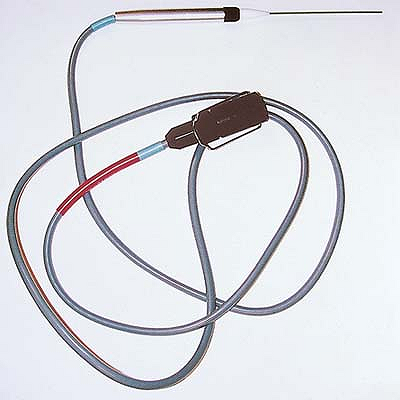Cryoneurolysis of Peripheral Nerves
Editors: Chelly, Jacques E.
Title: Peripheral Nerve Blocks: A Color Atlas, 3rd Edition
Copyright ©2009 Lippincott Williams & Wilkins
> Table of Contents > Section VII – Pain Blocks > 62 – Cryoneurolysis of Peripheral Nerves
62
Cryoneurolysis of Peripheral Nerves
Nashaat N. Rizk
Harinarayan Balasubramanian
After aseptic preparation and local anesthetic infiltration of the
skin, insert an intravenous catheter over a needle through the skin and
direct it closely toward the area to be frozen. Remove the needle and
insert the cryoprobe (Fig. 62-1)
through the catheter. Use the nerve stimulator in the cryoprobe to
place the tip in the exact location. The typical duration of the
cryolesion is 1.0 to 1.5 minutes. The best results are obtained with
the technique of “freeze-thaw-refreeze” cycle. Once the 1.5-minute
freezing cycle at -60°C to -80°C has been performed, allow the probe to
thaw for 20 to 30 seconds and again refreeze for another 1.5 minutes. A
minimum lesion length of 4 mm is critical in order to stop nerve
conduction.
-
Precise localization of the probe is necessary.
-
Avoid cryoneurolysis of the motor nerves.
-
Test the cryosurgical equipment thoroughly before using to ensure that there is no leak.
P.417
 |
|
Figure 62-1. Cryoprobe.
|
Suggested Readings
Patt RB, Cousins MJ. Techniques for neurolytic neural blockade. In: Cousins MJ, Bridenbaugh PO, eds. Neural blockade in clinical anesthesia and management of pain, 3rd ed. Philadelphia: Lippincott-Raven, 1998.
Saberski L, Fitzgerald J, Ahmad M. Cryoneurolysis and radiofrequency lesioning. In: Raj PP, ed. Practical management of pain, 3rd ed. Philadelphia: Mosby, 2000.
Waldman SD. Atlas of interventional pain management. Philadelphia: WB Saunders Co, 1998.
